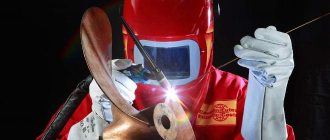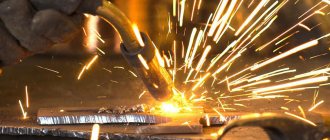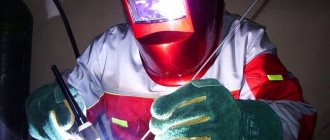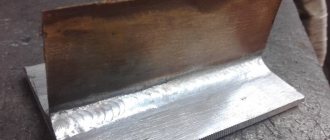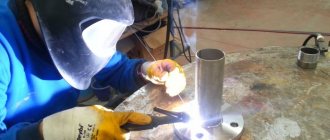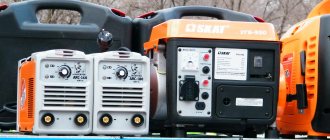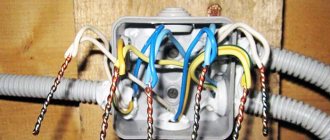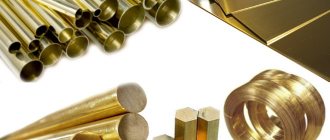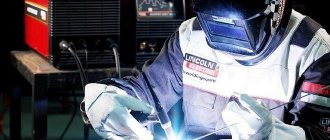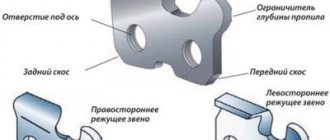Among all types of welding, brass welding is one of the most complex technological processes. This is explained by the fact that zinc, which is part of this copper alloy, begins to actively evaporate when heated, which leads to the formation of pores in the weld and, accordingly, to a significant deterioration in the quality and reliability of the joint being formed. Welding brass parts is also complicated by the fact that when it is performed, zinc vapors are released, which are very harmful to human health.
Argon welding of copper alloy
Features of welding work with copper alloys
Brass is often compared to bronze. After all, bronzes are also alloys in which copper is present, and the second main component can be aluminum, silicon, lead, beryllium, and so on.
The thermal conductivity of copper is 6 times greater than that of iron. And therefore, the technology for welding copper alloys has serious differences from the technology for welding steel and iron products
It is also important to note that things made of brass or bronze often have decorative value. This means that when welding you need to use the mode that will allow you to get a perfectly smooth seam and give durability to the connection.
All copper alloys have certain common features, but each of them also has its own unique properties. For example, the fact that it contains zinc is of particular importance when working with brass.
It is this element from the periodic table that makes welding brass so difficult. There are several difficulties that craftsmen encounter during this process:
- gases are absorbed by the molten metal (zinc oxidation occurs and hydrogen bubbles appear in the weld);
- Pores and cracks easily form on brass when overheated;
- Zinc begins to burn out of the alloy, since it has a lower boiling point than copper.
To combat all the difficulties during welding, the protective environment of argon is used. Other types of welding are also used, not forgetting about the preparation of the material and strict adherence to the process technology.
Peculiarities
Brass can be welded, but this process is considered technologically complex. The components included in its composition in the form of zinc and copper differ in physical and chemical properties, therefore, they behave differently under the same conditions. Despite this, welding is, in principle, possible. If you learn all the features of the behavior of metals, you can carry out welding using trivial methods, and at home. In its technology, the process is similar to copper welding.
There are several traditional obstacles that every welder faces when carrying out the welding process. The main problem is the large gap between the melting temperatures of the metals that make up the brass alloy.
If the melting point for copper is 1080°C degrees, then zinc melts at 420°C, and at 905°C degrees zinc begins to boil (at normal pressure).
As a result of the action of the electric arc, the zinc melts and boils. From the place where the seam is formed, it gradually evaporates and burns out.
Zinc reacts with oxygen during the welding process. The resulting oxide in the form of a film covers the part. It forms precisely in the seam zone, but it is this film that prevents normal fusion. In addition, pores and cracks quickly begin to appear in brass when heated. They are due to the fact that as the temperature rises, the process of hydrogen absorption begins. It forms bubbles in molten metal. As a result, the porous structure of the seam negatively affects its strength.
To summarize the presented theory, we can identify three main problems characteristic of welding brass:
- evaporation and burnout of metal (zinc);
- formation of pores and cracks;
- formation of zinc oxide (white film).
Preparation
Today, in practice, when working with bronze and brass, electric arc, gas flame and argon welding is used. But regardless of which technology was chosen, it is necessary to carefully prepare the metal surfaces that are supposed to be welded.
To do this, special welding edges should be cut along the edges of the workpieces, and the future seam area should be polished until shiny using sandpaper and a file.
Oxides often form on brass surfaces, which also need to be removed . This can be done using a solution of hydrochloric or nitric acid. Moreover, such cleaning should be carried out strictly before starting welding work.
Welding brass products using gas
Gas welding technology is used when there is no electricity or electric arc welding does not provide the expected result. The gas welding process guarantees the strength of the seam, but has a significant drawback - large evaporation of zinc. An oxidizing flame is used to reduce the volume of released zinc. Thanks to the flame, a film of zinc oxide is formed on the surface, preventing the substance from entering the air.
Gas welding
The welding flame affects the strength of the seam, so the flame power is selected based on the optimal acetylene consumption. To avoid overheating of the metal, this flow rate should be from 100 to 120 dm³/h per millimeter of surface thickness. The welding flame is directed onto the filler material located at right angles to the nozzle. The end of the filler rod should be kept in the flame at all times. The welding speed should be maximum.
In the gas welding process, self-fluxing filler wire is used; no additional flux is required. You can use silicon brass wire, which increases the strength and density of the seam. The cross-section of the additive is selected depending on the parameters of the alloy being joined.
The slags that form during welding are washed off with water. After welding, to ensure density, strength, and fine-grainedness of the weld, it is forged and subsequently annealed with gradual cooling.
Care should be taken when creating ceiling joints, taking into account the fluidity of the molten material. In this case, the flame power should be reduced.
The essence of gas welding
Electric arc
For standard electric arc welding, it is best to use electrodes made of brass wire (and the share of zinc in this wire should be 40%) with inclusions of aluminum, iron, lead, and manganese.
When the device is turned on, a constant electric current of direct polarity must pass through these electrodes. In this case, welding is carried out with a short arc from a position from below.
The arc must be maintained at a current of 250 amperes for electrodes 5 mm long. In this case, the speed of laying the seam can reach 30 cm per minute.
At the end of the main operation, the weld should be additionally forged and heated to a temperature in the range from 600 to 650 °C. This will give the connection greater strength.
What difficulties are associated with the process of welding non-ferrous metals and alloys?
When working with non-ferrous metals and alloys, special protective measures must be taken. Otherwise, the negative processes will intensify and form a melted oxide build-up at the weld site.
It is very important to create the proper conditions for welding - to limit the access of oxygen to the work area or to clearly regulate its supply.
The varieties of non-ferrous metals that are most in demand are difficult to find in their natural form. Therefore, in order to obtain a substance with the desired chemical properties, production usually uses alloys - complex combinations and combinations of non-ferrous metals.
Most often, craftsmen weld products from aluminum, bronze, duralumin (an alloy of aluminum, copper, magnesium and manganese), copper, brass (a combination of zinc and copper), silumin (a combination of silicon and aluminum). Today, many welded products are also produced from aluminum-magnesium and aluminum-manganese alloys.
But the most popular non-ferrous metals that are used in industry and production are combinations of copper and aluminum with other metals (lead, zinc, magnesium, silicon, etc.). Such connections include:
- Aluminum combinations (duralumin, avial, silumin).
- Ordinary brass is an alloy of zinc and copper, in which the latter element occupies up to 70% of the total mass. In some cases, to achieve the desired condition of the product, the proportion of zinc is increased to 50%.
- Bronze is a classic combination of tin and copper (proportions: 15:85).
- Complex brasses - along with zinc and copper, they also contain various fillers and additives.
You need to choose the appropriate technology for welding non-ferrous metals and alloys taking into account the type of material you will have to work with.
Magnesium, copper and aluminum are known to cool quite quickly. This means that to work with them you will need a very high power energy source and additional heating. With alloys the situation is more complicated. The fact is that the elements included in their composition may have different melting points. Therefore, when working with them, there is a risk that lighter substances will evaporate. But by welding quickly, you can avoid this.
VT-metall offers services:
Features of welding non-ferrous metals and alloys are also due to their high affinity for oxygen. Some of them can even act as deoxidizers. The oxides that form during their melting are more refractory compounds that clog the welding seam. If you lower the melting point, cracks may appear on the surface. Obviously, this will negatively affect the mechanical properties of the joint. That is why welding of non-ferrous metals is often performed under a layer of flux, which reduces the effect of oxygen on them.
Due to their fragility and brittleness, some alloys can break with a slight impact or without any external influence at all. At the same time, materials that are too heavy can fail the weld pools with their weight. Therefore, when working with them, you need to be very careful.
Gas
Of course, you can also cook the surfaces of brass products with a gas apparatus. But in this case, work must be carried out at maximum speed. If the burner moves slowly, pores will form in the seam - this is again due to the characteristics of zinc melting. Ultimately, the operating speed should be approximately 25 cm per minute.
Welding with a gas machine must be performed without transverse vibrations, otherwise the brass product will begin to melt. Experts advise keeping the burner at right angles to the surface of the product. During the process, the filler wire must be positioned at an angle of approximately 30 degrees to the edges being welded.
Selecting filler material for welding brass
The choice of one or another brand of filler material greatly influences the progress of the brass welding process. The table below shows the composition of the most commonly used filler wires:
№
| Material grade | Chemical composition, % | ||||||
| Cu | B | Si | Sn | Ni | Impurities | ||
| 1 | LKBO 62-0.2-0.04-0.5 | 60,5-63,5 | 0,03-0,07 | 0,15-0,2 | 0,4-0,6 | — | — |
| 2 | LK 62-0.5 | 60,5-63,5 | — | 0,3-0,7 | — | — | 0,6 |
| 3 | LK 62-0.2 | 60,5-63,5 | — | 0,15-0,2 | — | — | 0,6 |
| 4 | LKN 56-0.3-6 | 55,0-57,0 | — | 0,25-0,3 | — | 5,5-6,0 | — |
| 5 | L 62 | 60,5-63,5 | — | — | — | — | — |
| 6 | L 68 | 67-70 | — | — | — | — | 0,3 |
| 7 | LK 80-3 | 78-82 | — | 3,0 | — | — | 0,3 |
| 8 | LO 60-1 | 60,5-63,5 | — | — | 0,5-1,0 | — | 1,0 |
| 9 | LOK 59-1-0.3 | 58-60 | — | 0,2-0,4 | 0,7-1,1 | — | 0,3 |
| 10 | LOC 62-0.4-0.5 | 60,5-63,5 | — | 0,3-0,7 | 0,3-0,5 | — | 0,5 |
| Note. The rest is zinc. | |||||||
Often, for welding conventional brass, filler wire of the L62 and L68 grades is chosen. These grades do not prevent zinc burnout, but the welding quality is good, the welds are strong and well formed.
The main disadvantage when welding conventional brass is the large number of defects in the welds in the form of pores. To obtain a denser weld and improve strength and technological characteristics, it is recommended to choose brass wire alloyed with deoxidizer elements. Good deoxidizers include aluminum, silicon, nickel, manganese and sometimes silver.
Filler material No. 1 contains boron and is self-fluxing. The choice of this filler material eliminates the use of flux and increases welding time by 20-40% compared to submerged arc welding.
Filler metals No. 2 and 3 are silicon brass. They provide a low-smoke welding process. When using them, zinc loss is only 2%. Filler material No. 4 contains zinc and provides a smokeless welding process. Material No. 4 was developed primarily for welding cast iron or steel to brass, but can be successfully used to weld alloyed and unalloyed brass.
Materials No. 5 and 6 are used when welding brass grades L62 and L68 with powder or gas fluxes.
Compositions No. 8, 9, 10 contain tin and silicon in their composition. These materials show the best results for oxy-acetylene welding of brass. The use of such filler wire makes it possible to obtain high corrosion resistance of the welded joint in sea water.
In an argon environment
Argon welding of brass is the highest quality and most popular option today. Moreover, this is true not only for brass, but also for other copper alloys.
This method is the same arc welding, but in an inert argon gas environment. And here it is possible to use both consumable and non-consumable electrodes.
Tungsten is usually used as a material for non-consumable electrodes. And in most cases, bronze rods of the BrKMts-3-1 brand can become a good filler material.
However, if the brass alloy is very complex, then filler wire should be used from the same material as the metal product itself.
Welding bronze or brass with an argon apparatus is performed in one layer. And at the same time, you need to cook not with a whole seam, but in small separate sections (rollers).
Here you need precision and accuracy, because the probability of a burn is quite high. In particular, because of this, welding of brass with argon is carried out using a long arc. And the master must gradually reduce the current in the welding zones in order to achieve a normal result.
Due to the technology features described above, it is best to use argon welding on products with a thickness of more than 5 millimeters.
Preparing brass parts for welding
Due to the fact that the thermal conductivity of brass is lower than that of copper, preheating is not required when welding brass of small and medium thicknesses. When welding thick brass, it is advisable to carry out local preheating.
The cutting of welded edges for butt welding is carried out based on the thickness of the metal being welded. When welding brass sheets up to 1.5 mm thick, it is recommended, if possible, to flange the sheets. The height of the flange is equal to twice the thickness of the metal being welded.
When welding brass with a thickness of 1.5-6mm, it is allowed not to prepare the welded edges; there should be a gap of 1-2mm between the parts being welded. If pads are used, the gap can be increased to 3-4mm. To ensure complete penetration throughout the entire thickness of the metal, double-sided welding is used.
When the thickness of the brass being welded is 6-25mm, a V-shaped groove of the welds is performed, although an X-shaped groove (if possible) with an opening angle of 30-45° on both sides is more preferable. Joint edges should be blunted. The amount of blunting is 4mm. With increased gaps, the quality of welded joints decreases. And with small gaps and long welds, stresses in the welded structure increase, which leads to its deformation.
Stud welding
Often there is a need to attach studs with a diameter of 8-12 millimeters made of pure copper or its alloys to steel, or vice versa. In this case, direct current of reverse polarity is used. The flux used is rather fine OSTS-45. No heating required.
Studs made of copper or brass L62 up to 10-12 millimeters in cross-section with a current strength of 400 amperes attach quite well to steel or cast iron elements. Brass LS 59-1 is not used.
Steel studs are very difficult to weld to copper or brass. A more or less normal result can be achieved by putting a copper ring with a height of 4 millimeters and a diameter of up to 8 millimeters on the end of a steel pin. To achieve good results, it is recommended to use K-100 electrodes.
Can brass fittings be welded to a steel pipe with a regular electrode?
Can brass plumbing fittings (or who knows what they are usually made of) be welded to a steel pipe with a regular electrode?
Of course not! What exactly do you want?
SergeyE wrote: (or who knows what they are usually made of)
There is also brass. There is also a silumin alloy. They can even do “sub-brass” coating. Could also be copper. and stainless steel. and plastic. and cast iron
SergeyE wrote: Can brass plumbing fittings (or who knows what they are usually made of) be welded to a steel pipe with a regular electrode?
Can. It will just fall off.
SergeyE” >
I tried it and it didn’t cook
The very meaning of the event is not clear!
SergeyE wrote: Can brass plumbing fittings (or who knows what they are usually made of) be welded to a steel pipe with a regular electrode?
they can be screwed to a steel pipe. And weld the threads.
ASN wrote: they can be screwed to a steel pipe. And weld the threads.
Or cut into chunks
Along the way, the topicstarter is just making fun of the crowd
Garik_31 wrote: Along the way, the topicstarter is just making fun of the crowd
But he didn’t find any brass electrodes.
Welding quality
This welding method is used in many fields. It is used to connect and manufacture metal structures for various purposes. The method is often used in the production of various devices, most often for the chemical industry. The machine, ship and carriage industries often resort to this method of joining brass parts. However, the manual method is suitable for one-time or infrequent work. In the case of production in large quantities, manual work is impractical, as it takes a lot of time and is less accurate. It is being replaced by more high-tech options, such as automatic and semi-automatic welding.
The strength of the weld is highly dependent on the thickness of the metal being joined. Optimal strength indicators are achieved with a copper thickness of 4-6 millimeters. When using silicon-alloyed wire, it is possible to achieve high weld strength that is not inferior in performance to the base metal of the part.
An increase in thickness leads to a decrease in strength by approximately 10-20%. This occurs due to a decrease in the speed of welding work.
How is copper welded to steel?
In reality this is quite a difficult task. But a good welder can still cope with such a task. Such compounds are used in the production of chemical equipment parts. One of the options encountered is to connect a copper wire to a steel block. The welding quality indicators of such joints are quite sufficient for their task. To increase the strength characteristics of copper products, up to 2% iron is added to the composition. It is not recommended to use a larger volume, as the strength will begin to decrease.
For welding work using graphite electrodes, direct current of direct polarity is used. In this case, the arc length of electricity should be in the range from 14 to 20 millimeters, and the voltage from 40 to 55 volts. The current is selected depending on the quality of the electrode and its diameter. Typically it is in the range of 300-550 amperes. Fluxes are used exactly the same as for working with copper. Their composition can be viewed on this page. Flux should be poured between the cutting edges into the welding area.
You should start welding from the left. The best result is achieved when processing with a “boat”. The process is carried out as follows:
- First, heat the edges of the copper product with a carbon electrode.
- Then the parts are connected in a certain position of the filler rod and the electrode. The rod should be inclined against the movement at an angle of 30-40 degrees to the metal. The electrode should be inclined in the direction of welding at an angle of 75-85 degrees.
At home
At home, the easiest way is to use an existing or borrowed blowtorch and tin solder. And as a flux, that is, a material that separates the welding zone from atmospheric air, you can use cheap and accessible sodium borate. Sometimes special solders from copper and silver are prepared for soldering brass.
If you are going to weld brass at home using the electric arc method, you need to think about protective equipment and strict precautions. Zinc vapor poses a truly serious danger to human health - it is poisonous.
Therefore, when welding brass, it is imperative to wear a protective mask, gloves and a respirator. For the same reason, it is better to perform this process outdoors or in rooms with sufficiently powerful hoods.
Less experienced craftsmen will benefit from additional advice. First, it is advisable to practice on an unnecessary piece of brass of suitable sizes. Only after getting good at it and setting the correct settings for the device can you get down to real work.
Those who want to quickly join two metal objects should know what cold welding is. Although this name is not entirely correct. Relatively speaking, hitting two metal plates with a sledgehammer, as a result of which you can get a single product (and this is exactly what they did in ancient times), can also be considered cold welding.
But these days, this is what they call the connection of two metal parts thanks to special compounds, as well as these compounds themselves. They can be purchased at almost any specialty store and allow you to connect, repair and seal brass and bronze products.
The method of application is extremely simple: you need to stir the cold welding composition until you get a homogeneous mass. Then you should apply this mixture to both surfaces that need to be connected and press them tightly against each other for a few seconds .
In fact, cold welding is the glue for metals, and sometimes such glue can actually solve related problems at home. On the other hand, there are situations when real welding is indispensable.
Welding technology for non-ferrous metals using copper as an example
The positive characteristics of copper include: high ductility, thermal conductivity, heat capacity, electrical conductivity and corrosion resistance. To this list should be added insensitivity to cold and preservation of high plastic properties after annealing. All these unique qualities make it possible to widely use copper and its combinations in various industries.
Distinctive properties of copper: density - 8.96 g/cm3, relative elongation - 50%, temporary resistance in the absence of cold hardening - 20 kgf/mm2 (200 MPa), melts at a temperature of 1083 °C.
The purity of copper has a direct impact on its weldability. Those products that contain a minimum amount of harmful impurities are better welded. The oxygen content in deoxidized copper does not exceed 0.01%. This means that it welds best. Impurities that impair the weldability of copper and reduce its mechanical qualities are lead, bismuth, and sulfur.
We recommend articles on metalworking
- Steel grades: classification and interpretation
- Aluminum grades and areas of their application
- Defects in metal products: causes and search methods
When hydrogen is present in molten copper, it also negatively affects welding. The seam crystallizes and hydrogen combines with oxygen from cuprous oxide, resulting in the formation of water vapor. Because of these vapors, hydrogen disease occurs. The fact is that when the weld crystallizes, water vapor tries to escape and, as a result of these efforts, forms many cracks and pores. This process is reflected in the formula Сu2O+H2=2Cu+H2O↑.
Manual welding of parts made of non-ferrous metals is carried out using metal or carbon electrodes using coatings and fluxes. In addition, it is carried out in a protective gas environment.
Carbon electrode welding. Copper parts should be connected using direct current of straight polarity, a graphite or carbon electrode.
Maintain an arc length of 35–40 mm, and use rectangular or round copper rods (“M1”, “M2”) and rods with a phosphorus additive (deoxidizer) as filler material. It is best that the cross-section of the filler rod is 20–25 mm2. Then it will not oxidize too much and overheat in the process of melting the non-ferrous metal.
The flux here is a mixture of 5% metal powdered magnesium and 95% calcined borax or fusion borax. Before you begin welding non-ferrous metals, powdered fluxes should be applied to the edges to be welded or the surface of the filler rod, moistened with liquid glass. And then air dry them.
Before applying flux, wash the edges of the workpiece and the filler rod with a 10% caustic soda solution or clean them with a wire brush.
When welding copper parts with a carbon electrode, use rods containing no more than 1% silver, up to 0.2% phosphorus, and the rest copper as filler metal.
Apply preheating to ensure good fusion of the base material and the next one with the filler material. When welding simple small components (tires, tips), you can perform heating with the carbon arc itself.
Large-sized products must be preheated in electric ovens with a protective atmosphere to a temperature of +500 °C. Nitrogen can act as a shielding gas.
Please note that when heated above +400 °C, copper begins to oxidize intensively. In this case, copper (I) oxide (Cu2O) is formed, which dissolves in the non-ferrous metal. As a result, copper becomes brittle. Therefore, it must be heated in a protective atmosphere.
Welding copper products up to 4 mm thick with a carbon electrode is performed using the “left” method, without beveling the edges. In this case, the electrode should be placed between the filler and deposited non-ferrous metal. And parts with a thickness of more than 4 mm are welded with beveled edges, using the “right” method. Then the cutting angle is 70–90°, and filler rods are placed between the electrode and the deposited non-ferrous metal.
Table of modes for manual arc welding of copper with graphite and carbon electrodes:
When assembling copper products and assemblies, the gaps at the places where seams are applied should be minimal and not exceed 0.5 mm. This will avoid through burns and leaking seams.
In this case, welding of non-ferrous metals is carried out in the lower position, observing a strict sequence: first the working surface is heated, then showered with flux and heated until melted by an electric arc, after which the non-ferrous metal is supplied.
When the seam is filled with the end of the filler rod, additional flux should be added to the weld pool. In this case, it is important that the filler metal, after melting it by the heat of the arc, fuses well with the base non-ferrous metal. If the heating temperature of the area is insufficient, the filler metal will curl into balls. And this will lead to incomplete cooking. Try to fill the seam in one pass, since multi-layer welding may cause pores to form in its outer layers.
At the end of welding, forge the deposited non-ferrous metal and anneal it, heating to +500...+550 °C and cooling in water. This is done in order to increase its viscosity.
Welding with a metal electrode. This method is suitable for working with copper products with a thickness of more than 2 mm, used in the form of rolled products.
If the additive is ordinary electrolytic copper wire, use flux of the following composition (in % by weight):
- dehydrated borax;
- boric acid;
- sodium phosphate.
Thanks to the last element in the flux, acids are more completely removed from the molten non-ferrous metal.
Preparation, heating of the product and subsequent processing of the welded joint are carried out in the same way when using carbon and metal electrodes.
Non-ferrous metal deposited with electrodes has good ductility and greater strength.
If it is necessary to obtain a deposited non-ferrous metal that is similar in composition to the base metal, then it is welded with electrodes of a different type. This is done using direct current of reverse polarity with a short arc. The electrode moves without hesitation, only progressively. In this case, the current must be sufficient to ensure welding.
The posts are powered from multi-post generators or from PS-500 generators. And to improve the quality, boron slag should be used as a flux. The latter is obtained by fusing without air access 95% of calcined borax and 5% magnesium. In an environment of nitrogen and argon, welding must be performed with a carbon or tungsten electrode using a special electrode holder, which ensures the supply of shielding gas to the arc combustion zone.
Manual argon arc welding. This method requires the presence of inert substances such as argon and helium in the protective gases.
Welding of non-ferrous metals with argon is carried out with a tungsten electrode using direct current of straight polarity with general heating of the product to a temperature of +350...+400 °C. Bronze wire (“KMtsZ-1”, etc.) is used as a filler material.
The work can be done using both the “left” and “right” methods. Before starting, the arc is excited on a carbon or graphite plate. After which it is transferred to the product. It is not recommended to light it on the product itself, because the tungsten electrode will melt and become dirty. Welding is performed in the ceiling, bottom or vertical position.
You can weld copper in argon and alternating current. Then the speed will decrease significantly, but the seam will look better externally than when using direct current. When working with alternating current with Br KMtsZ-1 wire, no drill is required for deoxidation. In this case, there will be no surface film on the molten non-ferrous metal. It will be removed due to cathode sputtering, which is based on the movement of positively charged ions at high speed to the cathode and its bombardment. Welding of non-ferrous metals using the described method is stable and can be carried out in any spatial position.
